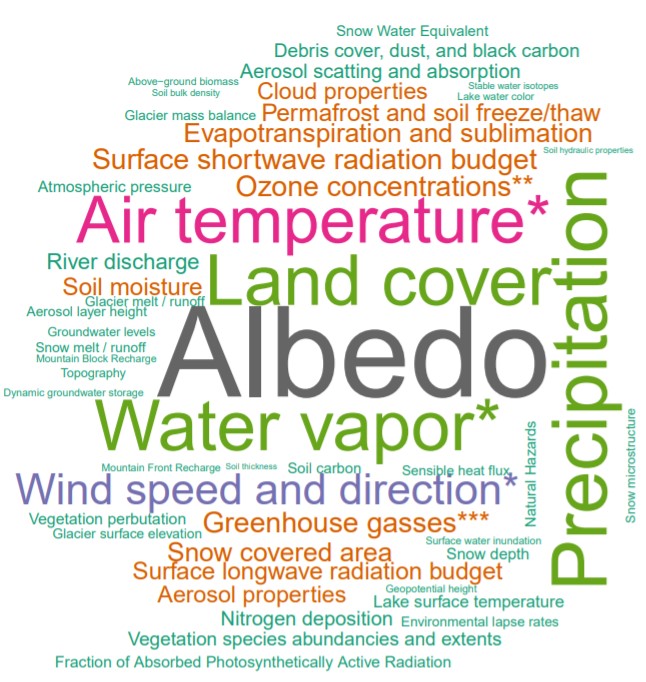Toward a definition of Essential Mountain Climate Variables

This article features work by Adaptation at Altitude Programme Partners MRI. Read their news release on this publication here.
Introduction
The numerous processes implicated in the rapid and profound climate-driven changes that are underway across the world’s mountains must be well monitored, understood, and — as far as possible — accurately projected. However, not only are the available environmental data upon which such activities hinge often severely limited, but interdisciplinary consensus regarding which variables should be considered observation priorities also remains elusive.
This perspective introduces Essential Mountain Climate Variables (EMCVs), which could be used to increase the utility of mountainous environmental data to both fundamental science and decision making related to environmental management, risk mitigation, and adaptation.
The text below provides a summary of the open access paper “Toward a definition of Essential Mountain Climate Variables” published in One Earth in June 2021. For much more detail you can read the full paper here. This open access article is licensed under a Creative Commons Attribution 4.0 International License (http:// creativecommons.org/licenses/by/4.0/). Please credit the authors and the full source.
The need for interdisciplinary observations
The availability of consistent, informative, and interdisciplinary environmental observations in mountains is paramount, inter alia, to developing sound conceptual understanding of complex mountainous systems and—by extension—generating reliable and useful predictions pertaining to them.
Defining such a set of priority mountain climate-related environmental variables and their associated attributes or “observation requirements” (which should be met to ensure usefulness) should enable fairer comparisons to be made across global mountain regions, contribute to answering many increasingly urgent scientific questions, and meet various policy needs. Below, a framework to support these tasks is proposed. needs. Below, a framework to support these tasks is proposed. Four specific questions are considered:
- What are the main components of mountainous environmental systems and their associated dominant climate-related drivers, processes, and impacts of ongoing and potential future change?
- Which specific corresponding variables should be observed as a priority for better understanding the mechanisms involved and their impacts, generating more reliable future predictions, and providing consistent data for reporting?
- What current and emerging possibilities exist for measuring or otherwise obtaining data on these variables?
- What additional steps should or must be completed if the concept is ultimately to be formalized?
Proposed solution: EMCVs
Background and guiding philosophy
To address the challenge(s) outlined, we propose the establishment of a set of so-called Essential Mountain Climate Variables (EMCVs). EMCVs can tentatively be defined as ‘‘physical, chemical or biological variables that either currently do, or potentially could, significantly contribute to the characterization of Earth’s mountainous environmental systems, especially under climatic change.’’ At this stage, our intention is merely to develop and present a preliminary set of candidate EMCVs that are ranked according to their perceived importance across disciplines rather than a firm, prescriptive classification of essential (and by extension non-essential) variables.
Identifying and ranking potential EMCVs
After the review of the four main mountainous environmental systems (i.e. Atmosphere, cryosphere, biosphere, hydrosphere), a preliminary set of potential EMCVs were identified and ranked according to a consensus view of perceived importance. The figure below (figure 2 p. 812 in the publication) provides a simplified, visual representation in the form of a ‘‘word cloud,’’ whereby term size is proportional to the ranking assigned.

Measuring EMCVs
Some established approaches for measuring or otherwise deriving selected potential EMCVs, along with relevant associated organizations and initiatives working on their collation and curation, where applicable, are summarized in the publication (p. 813 – 816).
Emerging and future possibilities
Numerous emerging or future initiatives that could facilitate the measurement, derivation, or application of EMCVs are now emerging.
Long-term in situ observatories
New high-quality mountain reference observatories could be established to facilitate the measurement of a wide range of EMCVs. Close collaboration and coordination between various authorities, researchers, and practitioners with different backgrounds would be required.
Given that different EMCVs can have contrasting ideal network configurations, a second approach could involve designing networks specifically to obtain richer information on the spatiotemporal variability of individual variables, such as air temperature or snow cover.
High-resolution satellite-based Earth observation
Satellite-based products constitute another important potential source of EMCV data. Currently, a large fleet of optical and radar satellites provide a constant, open, and accessible stream of data with high spatiotemporal resolution and wide geographical coverage. For mountain research specifically, the global coverage and regular repeatability of remote-sensing products in general and of EODCs more specifically can help overcome the relative scarcity of in situ data.
Climate-model reanalyses and future projections
Reanalyses are global or regional numerical weather model simulations into which observations from a range of sources are continuously assimilated. The resultant products therefore represent physically consistent ‘‘best estimates’’ of the historical state of the three-dimensional atmosphere and the land surface. Being gridded, they have ‘‘complete’’ spatiotemporal coverage and—like remotely sensed products—have considerable potential to complement traditional observational networks to improve our understanding of climate processes in remote, poorly observed mountain regions.
Climate-model projections that extend into the future under so-called representative concentration pathways are likewise critical to the generation of climate service products, such as regional or local climate change projections in mountain settings. Such projections ultimately inform climate policy and adaptation measures.
Integrating diverse datasets into models
The combined use of in situ data, remotely sensed EO data, and numerical models—not only for cross-validation but also for actual integration via calibration, data assimilation, or machine learning—offers numerous attractions and possibilities. Essentially, through such approaches, the benefits of the various techniques can be leveraged while their respective limitations are simultaneously. mitigated. Such limitations include the fact that in situ measurements are generally limited to point locations, satellite-based EO products are prone to data gaps and inaccuracies, and numerical models introduce various uncertainties in diverging from pure empiricism.
Suggested next steps
Numerous additional (and potentially iterative) steps must be undertaken if the concept is ultimately to become formalized. A “roadmap” toward the establishment of the concept of EMCVs and its eventual application is outlined in the figure below (figure 7 p. 821 in the publication).

Conclusions
This perspective article has described some initial steps that have been undertaken toward establishing a set of interdisciplinary variables that could form observation priorities in mountainous terrain. The concept is intended to provide much-needed structure to the design and implementation of environmental monitoring and data-generation strategies across the world’s mountains.
It is hoped that this in turn will not only contribute to substantial improvements in the understanding and prediction of climate-driven changes in such regions but also support sound decisions related to sustainable development, adaptation, and risk mitigation.
Suggested citation
Thornton, J. M., Palazzi, E., Pepin, N. C., Cristofanelli, P., Essery, R., Kotlarski, S., Giuliani, G., Guigoz, Y., Kulonen, A., Pritchard, D., Li, X., Fowler, H. J., Randin, C. F., Shahgedanova, M., Steinbacher, M., Zebisch, M., & Adler, C. (2021). Toward a definition of Essential Mountain Climate Variables. One Earth, 4(6), 805–827. https://doi.org/10.1016/j.oneear.2021.05.005
Further reading
Related resources
- Mountain Observatories: Status and Prospects for Enhancing and Connecting a Global Community
- Adaptation action and research in glaciated mountain systems: Are they enough to meet the challenge of climate change?
- Adaptation to Climate Change in the Andes: gaps in understanding and opportunities for knowledge management
- The Climate-Cryosphere-Water Nexus in Central Asia
(0) Comments
There is no content